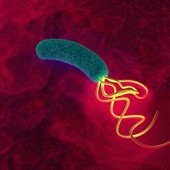Antibiotics — a life-saver that can be the pathway to chronic illness.
There is no doubt that antibiotics can save lives. In cases of acute infection, they are usually the medication of choice. But, the use of antibiotics can be a double-edged sword. How can antibiotics cause such widespread ill-health? And, what other ways are there to tackle the problem of infection?
To understand the problem, we have to begin with the discovery of penicillin. In 1928, Alexander Fleming observed that penicillium mould could destroy colonies of Staphylococcus aureus, and concluded that the penicillium must contain an antibacterial agent. Years later, scientists at Oxford University began intensive research and were able to demonstrate penicillin's ability to kill infectious bacteria, and so began the mass-production of penicillin. However, within only four years, microbes began to appear that were able to resist penicillin.
In the nineteenth century Pasteur discovered that the micro-organisms which spoiled food, could be removed by the process of heating, a technique which we know today as pasteurisation. Pasteur’s theory has become known today as ‘germ theory’, which advocates that there is an aggressive population of bacteria outside of the body, just waiting to gain entry and wreak havoc.
But Pasteur’s adversary, Bechamp, maintained that microbes were a dynamic ‘process’, and that they would either cause disease, or not, depending on the general state of the host. He believed that a completely healthy body would destroy harmful bacteria and that only when the body became compromised would the bacteria have a destructive effect. In fact Claude Bernard (1813-1878) stated, “The microbe is nothing, the terrain is everything”.
Modern allopathic medicine has tended to follow Pasteur’s approach, and it hasn’t taken into account the view maintained by Bechamp and Bernard. It is often the case that those patients who have infections, tend to have frequent infections, and that the prescription of antibiotics may well only be a temporary fix – although undoubtedly life-saving in some instances. However, it is now generally accepted that anitibiotics are not a long-term answer. But how do we clean up the terrain – the body? More of the solution shortly.
Meanwhile, what about the downside of over-prescription, which has produced increasing numbers of resistant bacterial strains? Everything in nature fights for survival, so why would pathogens be any different?
Today, most people have heard of candida. The current candidiasis epidemic is due, in large part, to the over-prescription of antibiotics. For those of you unfamiliar with the bacteria that live in our bodies, suffice to say that when things are in balance, these bacteria are of benefit to our health. They live in harmony with us, and exist on the surfaces which are generally external to the body, including the gut. It is this huge population of healthy bacteria (and candida to an extent) that constantly challenges the body’s immune system, so that it is better able to resist infections.
However, when antibiotics are prescribed, huge populations of ‘beneficial’ bacteria are wiped out, and other colonies begin to overgrow. We all have some candida in the gut. But, as soon as the bacterial count goes down, candida begins to overgrow and immunity is reduced, creating a more susceptible terrain, meaning future infections are more likely. Over the years, repeated use of antibiotics leads to larger and larger candida colonies, and poorer and poorer immune function.
So, returning to the terrain. A clean terrain is the answer if you want to avoid infections. The terrain can be cluttered with both pathogens and toxins – in fact, the more toxic the terrain, the more the pathogens abound. We could look at the natural world, and see that, in nature, pathogens are part of the decay and recycling process. So, the presence of pathogens shows that there is some spring-cleaning to be done. Most of the toxic debris comes in the form of heavy metals, particularly mercury, which tends to be ubiquitous these days, although there are thousands of other environmental toxins too. Natural Science Medicine can support you, once again, in claiming control of your body’s immune system.
The unique testing and methodology of FCT, aims to identify toxic invaders in your body’s organs and tissues, and systematically remove them to re-establish your body’s own natural immune system. Once the toxins - including antibiotic residues - are removed from the organs and tissues of the body, there is no need for an imbalance in the healthy community of bacteria (and funguses). What’s more, the immune system, no longer short of energy as a result of holding the toxins at bay, can get on with the job of restoring a natural flora. Health is restored, infections are far less likely. A healthy body will respond to the invasion of pathogens in a normal way, without buckling under the strain, and falling prey to secondary infections.
Click here for further information on Bacteria and Candida

In the USA the use of fluoroquinolones on animals has increased by 70% in 13 years. This particular antibiotic was first licensed for use in the UK poultry sector in 1993. Previous to this there had been no registered resistance of campylobacter, which is the most common cause of food poisoning, in people who had not been treated with the antibiotics. However, by 2007 almost half of the Campylobacter food poisoning cases caused by the most common strain were resistant.
Academic references